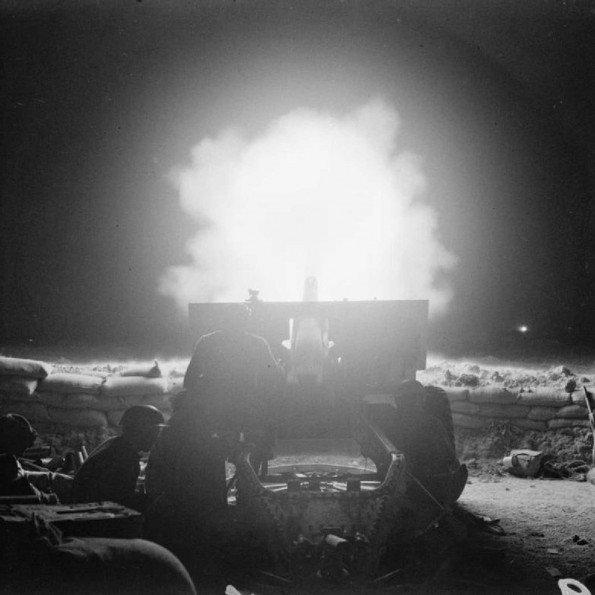
Kiwi Artillery Opens Up At Alamien, 21:30 Hrs, 23 October 1942
History begins here! Fully prepared 2nd NZ Division 25 pounder artillery guns begin spitting explosive steel during the opening stage of the El-Alamein assault.
With weeks, if not months of technical preparation behind them the 2NZEF artillery was finally ready and in position. Flanked by 51 Highland Division on their right and 1 South African Division to their left.
After the last few days of positioning and preparation we had our own 72 field guns with an additional 24 also under our command totalling 96. Each gun was supplied at its firing point with 664 heavy rounds of varying explosive types with protection from incoming fire applied best accordingly. Our gunners and drivers noticed the back breaking effort of moving these rounds, but were inspired by the effort and certainly ready to "Give Em Hell"
It is interesting to note that through each of these 72, 25 pounder guns our Kiwi gunners fired a total of 1384 rounds during the night of the opening Barrage. These hungry guns had its rounds stored in four positions, 664 rounds at the gun, 360 at the forward wagon line, 160 at the first rear wagon line and 200 rounds at the second rear line. With a constant relay and re-supply the transfer of rounds took place at specific intervals during this barrage. It was a huge physical effort to feed the frontline weapons, amazingly the 2nd NZ Divisional Artillery including the 24 field guns also under our command fired a total of 111,744 rounds during the night of the 23rd of October 1942. Incredibly each of these fired rounds were precisely timed and traced on a pre arranged grid pattern allotted to our sector. The distance the rounds travelled was then increasingly extended at a planned points to allow the chosen 2NZEF engineer and infantry Brigades with supporting mobile armour, to go in under the barrage. The leading Kiwi Engineers began clearing the many hundreds of German land mines in our sector 20 minutes after the first gun fired and this difficult task was called "Operation Lightfoot" The marked pathway required was 7.3metres wide by 8000 metres (8 Kilometres) long, such was the size and depth of the "Devils Garden" Unfortunately the sappers were unable to break through it by day break and many tanks became tangled up on the pathway.The engineers, more commonly called sappers were incredibly courageous removing these sensitive mines in the darkness, smoke, vibration and noise of battle, they were constantly under fire with best protection given by our infantry and close supporting rolling armour.
In many cases earlier, the sappers during the first battle of Alamien over July and May of 1942 at the Ruweisat Ridge and Mreir and at what is known as "The Battle of Tell El Eisa" the danger of dealing with mines was often lethal. During one mine clearing job, an entire truck load of 400 lifted mines accidently "went up" evaporating everything with-in a 50 metre radius, killing a number of sappers and wounding others. Mine clearing was especially hazardous.. but also was the more common job of placing them down, often under great pressure to rapidly create protection for our boys. Occasionally in those urgent circumstances, whoever was available to quickly learn and perform this critical duty within the Kiwi ranks was engaged to help and lay a protective blanket to deter the enemy from a vulnerable area or situation.
During the early daylight hours of the next morning we broke through the massive "Devils Garden" mine field defending the Axis forces, with mobile armour and infantry behind coming through to help crack open the vast German and Italian forces forward flanks. Unfortunately because of the delay getting through the minefield mobile armour had to take a wider route around the enemy right flank to keep the continuity and co-ordination of the assaulting process overnight..such is the required momentum of battle.
This day being D Day +1 was clear enough for the RAF Desert Air Force begin its nearly 1000 sorties flown, creating hellish hours of aerial bombing and strafing attacks in broad daylight after what would have undoubtably been a sleepless night for the North African invaders. Adolf Hitler while recieving a very bloody nose in Russia is also about to meet his match in Egypt..
Imperial War Museum, Denis Clough archive
Image available for Public Domain use as Crown Copyright Expired being created before 1st. June 1957

Takupu (0)